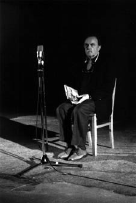|
Hallható fény
installációk
Helyszín: Trafó Stúdió
A műhelyen Johannes Kretz (Universität für Musik und Darstellende Kunst Wien) számítógépes zeneszerzés osztályának növendékei és Szigetvári Andrea (Liszt Ferenc Zeneművészeti Egyetem, Budapest) diákjai vesznek részt. A workshop célja interaktív zeneművek, installációk létrehozása lézerfény-hangszer segítségével. Technikai szempontból a produkció alapjául olyan, a színpadon kivetített lézersugarak szolgálnak, amelyek valamilyen mozdulattal történő átvágása hanggá alakítható vezérlőjelet bocsát ki. A műhelymunka már hónapokkal a fesztivál előtt elkezdődött Bécsben és Budapesten, a résztvevők MAX/MSP programnyelven írják műveiket, melyek végső 'hangolása', azaz az előadóterem és lézerfények által szabott feltételekhez alakítása a fesztivál első napján történik. Az elkészült munkák a fesztivál installációs terében (Trafó, Stúdió) láthatóak, hallhatóak február 15-től. A workshop osztrák résztvevői:
Matthias Kranebitter, Christoph W. Breidler, Fernando
Riederer, Wei-Ya Lin, Robert Kellner
|
|
|
|
Hallható fény installációk
gyerekeknek
Helyszín: Trafó Stúdió
Szombaton és vasárnap délután jó program lehet gyerekes családoknak meghallgatni, hogyan szólnak a lézersugarak. Ezekre az alkalmakra speciálisan gyerekek és gyermeki lelkülettel rendelkezők (6-99 éves korig) számára készült hangzások fognak megszólalni a lézerhangszeren. Az egyes installációváltásokkor rövid, egyszerűen megérthető magyarázatot, "használati utasítást" is adunk a "zenéléshez". |
|
|
|
Alvin LUCIER
(USA):
I am Sitting In a
Room
Helyszín: Trafó Stúdió
Alvin Lucier "I am Sitting In a Room" című darabja az elektroakusztikus zene klasszikusai közé tartozik. Az 1969-70-ben írt mű kottája egy utasítássorozat. Először ki kell választani egy termet, melynek zenei minőségeit szeretnénk éltre kelteni. Ezután egy adott szöveget fel kell olvasni, és ebben a teremben mikrofon segítségével felvételt készítünk róla. A felvett szöveget ezután hangszórón keresztül visszajátsszuk a terembe, és újra felvesszük. A visszajátszások és felvételek ciklusát addig ismételjük, amíg a tér – szűrőként viselkedve – a szövegből kiiktatja sz összes összetevőt a rezonáns frekvenciák kivételével. A végső eredmény a terem rejtőzködő, saját dallama. A darab írásának idején a felvétel/visszajátszás ciklusok analóg magnetofonok kapcsolgatásával zajlottak. A kottában a szerző több lehetőséget is felkínál a darab realizálására. Az egyik utasítás szerint elképzelhető jelenidejű installáció készítése is. A Making New Waves installációját MAX/MSP programnyelven írott program vezérli, mely a kiindulási szöveg rögzítése után automatikusan irányítja a következő felvételeket és lejátszásokat. Az első szöveget a szerző, Alvin Lucier fogja felolvasni nyilvános előadáson. |
|
kotta:
I'm sitting in a room, for voice and
electromagnetic tape. Necessary equipment: 1
microphone, 2 tape recorders(2 Nagras in 1980),
amplifier, 1 loudspeaker.
Choose a room the musical qualities of which you
would like to invoke. Attach the microphone to the
input of tape recorder n°1. To the output of tzpe
recorder n°2 attach the amplifier and loudspeaker.
Use the following text or any text of any length:
Record your voice on tape through the microphone attached to tape recorder n°1. Rewind the tape to its beginning, trnsfer it to tape recorder n°2, play it back into the room through the loudspeaker and record a second generation of the original recorded statement through the microphone attached to tape recorder n°1. Rewind the second generation to its beginning and splice it onto the end of the original recorded statement on tape recorder n°2. Play the second generation only back into the room through the loudspeaker and record a third generation of the original recorded statement through the microphone attached to tape recorder n°1. Continue this process through many generations. All the generations spliced together in chronological order make a tape composition the lenght of which is determined by the lenght of the original statement and the number of generations recorded. Make versions in which one recorded statement is recycled through many rooms. Make versions using one or more speakers of different languages in different rooms. Make versions in which for each generation, the microphone is moved to differnts parts of the room or rooms. Make versions that can be performed in real time. RESULT: The space acts as a filter; it filters out all of the frequencies except the resonant ones. It has to do with the architecture, the physical dimensions and acoustic characteristics of the space. Every musical sound has a particular wavelength; the higher the pitch, the shorter the wavelength. Actually there's no such thing as "high" notes or "low" notes, we simply borrowed those terms from the visual world to describe something we didn't undezrstand. A musical sound as it is produced on an instrument, in a column of air or vibrating string, causes oscillations at a certain rate of speed. For ex, the A that an orchestra tunes to vibrate at 440 times per second and can therfore be considered faster than th middle C on the piano that vibrates at about 262 times per second. But as those sounds move outinto space they can be observed as various-sized wavelengths, so you can see how directly the dimensions of a room relate to musical sounds. If the dimensions of a room are in a simple relationship to a sound that is played in it, that sound will be reinforced, that is, it will be amplified by the reflections from the walls. If, however, the sound doesn't "fit" the room, so to speak, it will be reflectedf out of phase with itself and tend to filter itself out. So by playing sounds into a room over and over again, you reinforce some of them more and more each time and eliminate others. It's a form of amplification by repetition. Thinking of sounds as measurable wavelengths, instead of as high or low musical notes, has changed my whole idea of music from a metaphor to a fact and, in a real way, has connected me to architecture.(Every room has its own melody, hiding there until it is made audible). |

